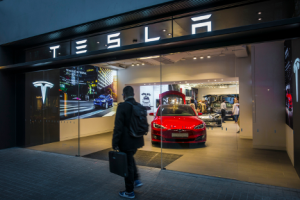Why I Won’t Touch Tesla With a 10-Foot Pole

There’s one company that appears immune to the pandemic…
But I wouldn’t touch it with a 10-foot pole.
Let me explain…
The market capitalization of a publicly traded company is calculated using a simple formula: market cap equals number of shares outstanding multiplied by current share price.
This number tells us what the stock market believes the company is worth on any given day.
Tesla (Nasdaq: TSLA) began 2020 with a very large market cap.
On January 1, its share price was $420. With 185 million shares outstanding, that gave Tesla a market cap of $77 billion.
And $77 billion is big – really big.
But then, the pandemic hit…
 Tesla’s share price soared up, up and away, from $420 to $1,537.
Tesla’s share price soared up, up and away, from $420 to $1,537.
While COVID-19 decimated economies across the planet, Tesla’s market cap went from $77 billion to $285 billion – a near fourfold increase in valuation…
During a pandemic-induced collapse of the global economy.
A $285 Billion Market Cap and Not a Penny of Profit
People can spin stories – but numbers don’t lie.
Tesla’s market cap is rocketing toward $300 billion. Meanwhile, the company has never once generated four consecutive profitable quarters.
The chart below shows Tesla’s trailing 12 months of income through the last quarter. You can see that the line never goes above zero.
 Meanwhile, other companies with market caps of roughly $300 billion have earnings in the neighborhood of the following…
Meanwhile, other companies with market caps of roughly $300 billion have earnings in the neighborhood of the following…
- The Home Depot (NYSE: HD) has a market cap of $280 billion and trailing 12-month earnings of $11 billion.
- UnitedHealth (NYSE: UNH) has a market cap of $292 billion and trailing 12-month earnings of $13.8 billion.
- JPMorgan Chase (NYSE: JPM) has a market cap of $299 billion and trailing 12-month earnings of $30.12 billion.
 Companies with comparable market caps to Tesla’s have trailing 12-month profits ranging from $10 billion to $30 billion. Tesla hasn’t made a nickel.
Companies with comparable market caps to Tesla’s have trailing 12-month profits ranging from $10 billion to $30 billion. Tesla hasn’t made a nickel.
Worse, its annual revenue doesn’t even reach what JPMorgan makes in a normal year.
Valued Like the Company Has a Permanent Monopoly
My skepticism doesn’t mean that I’m bearish on the electric car.
I believe its widespread adoption is coming even faster than most people anticipate.
Of course, that means there is huge sales growth coming for companies that manufacture it…
But Tesla does not own the electric car business.
Yet its market cap suggests that it has been granted a 100% monopoly.
In reality, all of the traditional auto manufacturers are also developing electric cars. Tesla is facing incredible competition from much deeper-pocketed competitors.
And whether auto manufacturers produce vehicles with electric or traditional combustion engines, the one thing that history has shown us about the industry is that it is very difficult to consistently turn a profit.
Intense competition and a capital-intense industry aren’t generally the recipe for huge profits – so nobody really knows whether Tesla will ever make a decent profit.
Assuming Tesla is going to someday turn a profit that justifies its current near-$300 billion market cap is another matter completely…
This business’s shareholders are taking a giant leap of faith.
So when a friend recently asked me if I would touch shares of Tesla, I said, “Not with a 10-foot pole!”
You can find market valuation and revenue data easily on sites like Yahoo Finance. Take a careful look at your trendiest holdings and determine whether you’re willing to make that 10-foot (or $300 billion) leap of faith.
Good investing,
Jody






